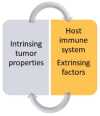Estrogens, Cancer and Immunity
- PMID: 35565393
- PMCID: PMC9101338
- DOI: 10.3390/cancers14092265
Estrogens, Cancer and Immunity
Abstract
Sex hormones are included in many physiological and pathological pathways. Estrogens belong to steroid hormones active in female sex. Estradiol (E2) is the strongest female sex hormone and, with its receptors, contributes to oncogenesis, cancer progression and response to treatment. In recent years, a role of immunosurveillance and suppression of immune response in malignancy has been well defined, forming the basis for cancer immunotherapy. The interplay of sex hormones with cancer immunity, as well as the response to immune checkpoint inhibitors, is of interest. In this review, we investigate the impact of sex hormones on natural immune response with respect to main active elements in anticancer immune surveillance: dendritic cells, macrophages, lymphocytes and checkpoint molecules. We describe the main sex-dependent tumors and the contribution of estrogen in their progression, response to treatment and especially modulation of anticancer immune response.
Keywords: cancer; estrogens; immunity.
Conflict of interest statement
The authors declare no conflict of interest.
Figures





Similar articles
-
Sex Hormones and Anticancer Immunity.Clin Cancer Res. 2019 Aug 1;25(15):4603-4610. doi: 10.1158/1078-0432.CCR-19-0137. Epub 2019 Mar 19. Clin Cancer Res. 2019. PMID: 30890551 Review.
-
Eosinophilia in cancer and its regulation by sex hormones.Trends Endocrinol Metab. 2023 Jan;34(1):5-20. doi: 10.1016/j.tem.2022.11.002. Epub 2022 Nov 26. Trends Endocrinol Metab. 2023. PMID: 36443206 Free PMC article. Review.
-
The Impact of Estrogen in the Tumor Microenvironment.Adv Exp Med Biol. 2020;1277:33-52. doi: 10.1007/978-3-030-50224-9_2. Adv Exp Med Biol. 2020. PMID: 33119863
-
Sex hormone adjuvant therapy in rheumatoid arthritis.Rheum Dis Clin North Am. 2000 Nov;26(4):881-95. doi: 10.1016/s0889-857x(05)70174-5. Rheum Dis Clin North Am. 2000. PMID: 11084949 Review.
-
Estrogen receptors regulate innate immune cells and signaling pathways.Cell Immunol. 2015 Apr;294(2):63-9. doi: 10.1016/j.cellimm.2015.01.018. Epub 2015 Feb 7. Cell Immunol. 2015. PMID: 25682174 Free PMC article. Review.
Cited by
-
Significance of dysregulated M2 macrophage and ESR2 in the ovarian metastasis of gastric cancer.Transl Cancer Res. 2024 Jun 30;13(6):2674-2690. doi: 10.21037/tcr-24-124. Epub 2024 Jun 20. Transl Cancer Res. 2024. PMID: 38988946 Free PMC article.
-
Sex-specific outcomes in cancer therapy: the central role of hormones.Front Med Technol. 2024 Feb 1;6:1320690. doi: 10.3389/fmedt.2024.1320690. eCollection 2024. Front Med Technol. 2024. PMID: 38362126 Free PMC article. Review.
-
Impact of relative estradiol changes during ovarian stimulation on blastocyst formation and live birth in assisted reproductive technology.Sci Rep. 2025 May 5;15(1):15617. doi: 10.1038/s41598-025-00200-5. Sci Rep. 2025. PMID: 40320433 Free PMC article.
-
The Role of Estrogen across Multiple Disease Mechanisms.Curr Issues Mol Biol. 2024 Jul 29;46(8):8170-8196. doi: 10.3390/cimb46080483. Curr Issues Mol Biol. 2024. PMID: 39194700 Free PMC article. Review.
-
Complex role of oestrogens in the risk and severity of rheumatoid arthritis in menopause.RMD Open. 2023 Jun;9(2):e003176. doi: 10.1136/rmdopen-2023-003176. RMD Open. 2023. PMID: 37321667 Free PMC article. No abstract available.
References
-
- Nilsson S., Gustafsson J.-A. Estrogen Receptors: Their Actions and Functional Roles in Health and Disease. Springer; Dordrecht, The Netherlands: 2010. pp. 4398–4410.
-
- Reyes-Garcia J., Montano L.M., Carbajal-Garcia A., Wang Y.X. Sex Hormones and Lung Inflammation. Adv. Exp. Med. Biol. 2021;1304:259–321. - PubMed
Publication types
LinkOut - more resources
Full Text Sources

